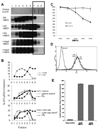Differential requirement of lipid rafts for FcγRIIA mediated effector activities
- PMID: 20728077
- PMCID: PMC2975250
- DOI: 10.1016/j.cellimm.2010.07.011
Differential requirement of lipid rafts for FcγRIIA mediated effector activities
Abstract
Immunoglobulin G (IgG) dependent activities are important in host defense and autoimmune diseases. Various cell types including macrophages and neutrophils contribute to pathogen destruction and tissue damage through binding of IgG to Fcγ receptors (FcγR). One member of this family, FcγRIIA, is a transmembrane glycoprotein known to mediate binding and internalization of IgG-containing targets. FcγRIIA has been observed to translocate into lipids rafts upon binding IgG-containing targets. We hypothesize that lipid rafts participate to different extents in binding and internalizing targets of different sizes. We demonstrate that disruption of lipid rafts with 8mM methyl-β-cyclodextrin (MβCD) nearly abolishes binding (91% reduction) and phagocytosis (60% reduction) of large IgG-coated targets. Conversely, binding and internalization of small IgG-complexes is less dependent on lipid rafts (49% and 17% inhibition at 8mM MβCD, respectively). These observations suggest that differences between phagocytosis and endocytosis may arise as early as the initial stages of ligand recognition.
Copyright © 2010 Elsevier Inc. All rights reserved.
Figures





Similar articles
-
FcγRIIa requires lipid rafts, but not co-localization into rafts, for effector function.Inflamm Res. 2013 Jan;62(1):37-43. doi: 10.1007/s00011-012-0548-1. Epub 2012 Sep 4. Inflamm Res. 2013. PMID: 22945762
-
Association of FcgammaRIIa (CD32a) with lipid rafts regulates ligand binding activity.J Immunol. 2009 Jun 15;182(12):8026-36. doi: 10.4049/jimmunol.0900107. J Immunol. 2009. PMID: 19494328
-
Transmembrane mutations to FcgammaRIIA alter its association with lipid rafts: implications for receptor signaling.J Immunol. 2007 Mar 1;178(5):3048-58. doi: 10.4049/jimmunol.178.5.3048. J Immunol. 2007. PMID: 17312151
-
Cholesterol-Rich Lipid Rafts as Platforms for SARS-CoV-2 Entry.Front Immunol. 2021 Dec 16;12:796855. doi: 10.3389/fimmu.2021.796855. eCollection 2021. Front Immunol. 2021. PMID: 34975904 Free PMC article. Review.
-
Human platelet IgG Fc receptor FcγRIIA in immunity and thrombosis.J Thromb Haemost. 2015 Jun;13(6):893-908. doi: 10.1111/jth.12905. Epub 2015 Apr 21. J Thromb Haemost. 2015. PMID: 25900780 Review.
Cited by
-
Functional genomics screens reveal a role for TBC1D24 and SV2B in antibody-dependent enhancement of dengue virus infection.J Virol. 2024 Nov 19;98(11):e0158224. doi: 10.1128/jvi.01582-24. Epub 2024 Oct 8. J Virol. 2024. PMID: 39377586 Free PMC article.
-
Transduction of skin-migrating dendritic cells by human adenovirus 5 occurs via an actin-dependent phagocytic pathway.J Gen Virol. 2016 Oct;97(10):2703-2718. doi: 10.1099/jgv.0.000581. Epub 2016 Aug 15. J Gen Virol. 2016. PMID: 27528389 Free PMC article.
-
Modified vaccinia virus Ankara-based vaccine vectors induce apoptosis in dendritic cells draining from the skin via both the extrinsic and intrinsic caspase pathways, preventing efficient antigen presentation.J Virol. 2012 May;86(10):5452-66. doi: 10.1128/JVI.00264-12. Epub 2012 Mar 14. J Virol. 2012. PMID: 22419811 Free PMC article.
-
Impact of Plasma Membrane Domains on IgG Fc Receptor Function.Front Immunol. 2020 Jun 30;11:1320. doi: 10.3389/fimmu.2020.01320. eCollection 2020. Front Immunol. 2020. PMID: 32714325 Free PMC article. Review.
-
SREBP-1a-stimulated lipid synthesis is required for macrophage phagocytosis downstream of TLR4-directed mTORC1.Proc Natl Acad Sci U S A. 2018 Dec 26;115(52):E12228-E12234. doi: 10.1073/pnas.1813458115. Epub 2018 Dec 10. Proc Natl Acad Sci U S A. 2018. PMID: 30530672 Free PMC article.
References
-
- Gavin AL, Barnes N, Dijstelbloem HM, Hogarth PM. Identification of the mouse IgG3 receptor: implications for antibody effector function at the interface between innate and adaptive immunity. J Immunol. 1998;160:20–23. - PubMed
-
- Joshi T, Butchar JP, Tridandapani S. Fcgamma receptor signaling in phagocytes. Int J Hematol. 2006;84:210–216. - PubMed
-
- Hulett MD, Hogarth PM. Molecular basis of Fc receptor function. Adv Immunol. 1994;57:1–127. - PubMed
-
- Ravetch JV, Kinet JP. Fc receptors. Annu Rev Immunol. 1991;9:457–492. - PubMed
-
- Ganesan LP, Joshi T, Fang H, Kutala VK, Roda J, Trotta R, Lehman A, Kuppusamy P, Byrd JC, Carson WE, Caligiuri MA, Tridandapani S. FcgammaR-induced production of superoxide and inflammatory cytokines is differentially regulated by SHIP through its influence on PI3K and/or Ras/Erk pathways. Blood. 2006;108:718–725. - PMC - PubMed
Publication types
MeSH terms
Substances
Grants and funding
LinkOut - more resources
Full Text Sources
Other Literature Sources

